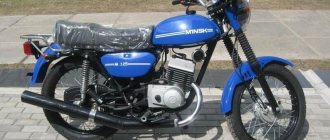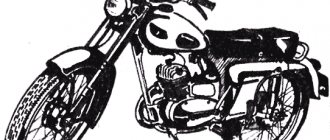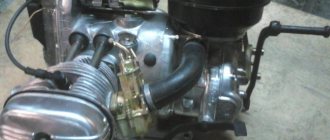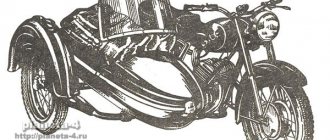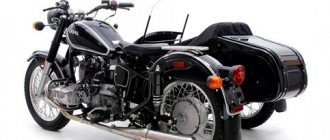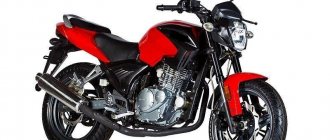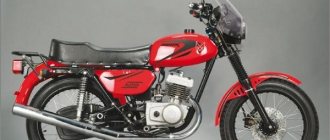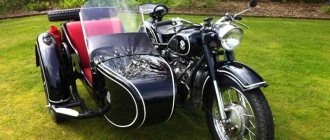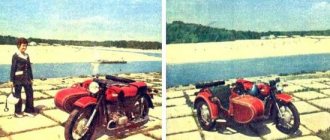The MMVZ two-stroke engine with a volume of 125 cm³ has been produced by the Minsk Motorcycle Plant for many years. From 1951 to the present, two-stroke 125 cc engines have been and continue to be produced in various models and modifications. The first motorcycle engine was 4.25 liters. s., at this time, the engine power is 12 hp. With. Structurally, no global changes were made to the internal combustion engine. The cooling remains the same air with two-channel return blowing. Despite the experience of world manufacturers of motorcycle engines using an ejector, the Minsk plant, unfortunately, did not replace the carburetor with an ejector, but it’s a pity, the engine would have had even more advantages.
The Minsk MMVZ-3.11211 has the engine 3.1122-10100-03. In its basic detailing, little has changed structurally in comparison with previous models and modifications of the 125 cm³ engine.
Differences between ICE 3.1122-10100-03 and previous engines:
- Main bearings are installed at the crankshaft cheeks to increase rigidity and improve engine stability, and oil seals are installed behind the bearings. On early models, the oil seals were installed first, followed by the bearings.
- The oil supply to the inner bearings from the crank chamber has been optimized, as well as to the left outer ball bearing from the oil cavity. In older internal combustion engine models, the right bearing was lubricated by oil supply from the gearbox, the left (inner and outer) bearings received oil from the cover cavity. The left inner bearing was not sufficiently lubricated.
- In order to increase the rigidity of the crankshaft, the diameter of the journals was increased from 17 to 20 mm; accordingly, bearings No. 304 were replaced by bearings 6-204 with a higher accuracy class. With a change in the bearing arrangement and an improvement in the lubrication system, the second oil seal on the right side of the crankshaft was removed to protect the generator. The right axle was shortened, at the same time the width of the right part of the crankcase and gearbox cover was reduced by 10 mm. Both parts of the crankcase and the left cover were shortened by 30 mm shorter and their shape was changed.
- To control the oil level in the crankcase, older engines had an oil dipstick; 3.1122-10100-03 does not have an oil dipstick; instead, there is a control hole with a plug.
Technical characteristics of motorcycle engines MMVZ "Minsk" 125
| Power units of motorcycle motorcycles "Minsk" MMVZ | 3.112 | 3.112.1 | 3.112.11 | 3.112.12 | 3.112.14 | 3.112.15 |
| Volume, cm3 | 123.6 (exact value) | |||||
| Compression ratio | 9,2 — 9,8 | 9,5 | 8,5 | 12 | ||
| Power, hp | 12 | 10 | ||||
| Max. speed, km/h | 95 | 85 | ||||
| Fuel consumption rate (average) per 100 km, l | 3,3-4,5 | 4,0-4,5 | 3,9-4,4 | 4,2 | ||
| Cylinder diameter, mm | 52 | |||||
| Piston stroke, mm | 58 | |||||
| Piston life, km | 15,000-20,000 (with two ring replacements) | |||||
| Cylinder life, km | 25,000-40,000 (with two piston replacements) | |||||
| Speed at max. power, rpm | 6400 | 6200-6900 | 6000-6500 | 6400 | ||
| Carburetor | K-62S | Micarb | K2401, P-47R, K-65S | |||
| Air filter | paper | |||||
| Gasoline used in the fuel mixture | A-80 | AI-92 | ||||
| Motor oil used in the fuel mixture | autol M-8 A (B, V) | |||||
| Proportion of gasoline and oil when preparing fuel | 25:1. During break-in 20:1. | |||||
| Fuel tank capacity, l | 11,5 | |||||
| Motor transmission chain | PV-9.525-1200 | |||||
| Gear ratio | 2,75 | |||||
| Clutch | Multi-disc, oil bath | |||||
| Number of master disks | 4 | |||||
| Gear box | 4-speed | |||||
| Gear ratios | I — 2.925, II — 1.78, III — 1.271, IV — 1.0 | |||||
| Final drive chain (closed) | PR-12.7-1800-2 | |||||
| Gear ratio | 2,8 | |||||
| Generator | G427 (6 V), 43.3701010 (12 V) | |||||
| Ignition coil | B300B (6 V), 2102.3705 (12 V) | |||||
| Engine life (before overhaul), km | 24 000 | |||||
Engine modification
Participation in motorsports requires a reasonable advantage over competitors. Therefore, many will think about how to increase the engine power of a Minsk motorcycle. To do this, you can perform several manipulations:
- Disassemble the engine.
- Rings are inserted into the crankcase and securely fastened, reducing the size of the crank chamber by several millimeters.
- More reliable oil seals with a high load rating are installed.
- It is recommended to install K-36 (carburetor). It will significantly increase the compression ratio.
- Ventilation windows are sawn to 20 mm.
- The length of the exhaust pipe should be increased to 310 mm.
- Replace the connecting rod in the crankshaft with a duralumin one.
- Install a larger air filter.
This boost can add more than 7 kW of power to the motor. Overall, the motorcycle is pleasant to move around the city and reliable when doing work. The lightness and controllability of Minsk have long established themselves among motorcyclists. Even now, at a gathering of bikers you can see several modified models of Minsk.
Repair dimensions of the cylinder, piston, rings of the MMVZ Minsk motorcycle engines 125 cm3
| Index | Cylinder | Piston | Rings | ||||
| group | size | group | size | size with gap 0.2+0.15 | |||
| Normal | ∅ 52 | -0,035 | ∅ 51,88-0,03 | ∅ 52 -0,01 | |||
| -0,065 | |||||||
| 0 | 51,965 — 51,955 | 0 | 51,88-51,87 | ||||
| 1 | 51,955 — 51,945 | 1 | 51,87-51,86 | ||||
| 2 | 51,945 — 51,935 | 2 | 51,86-51,85 | ||||
| 1 repair | ∅ 52.25 | -0,035 | ∅ 52,13-0,03 | ∅ 52,25 -0,01 | |||
| -0,065 | |||||||
| 0 | 52,215 — 52,205 | 0 | 52,13 — 52,12 | ||||
| 1 | 52,205 — 52,195 | 1 | 52,12 — 52,11 | ||||
| 2 | 52,195 — 52,185 | 2 | 52,11 — 52,10 | ||||
Reviews from owners of Minsk 125
I still remember my Minsk with warmth in my soul, I had my first motorcycle. The year of manufacture is unknown, the condition was ruined, I didn’t drive more than 90, it broke down three times a week, but what impressions!!! Instead of an air filter, there was an oily rag stuck into the carburetor, but it still drove)) I don’t even know how, the rubber was also twenty years old, and nothing)) This is where my love for motorcycles began. Victor, Krasnoznamensk, Minsk 125.
I still own three Minsks, one is in close to collectible condition, the other two act as donors of spare parts. Sometimes I go out for a ride on a “ceremonial” motorcycle in the summer, people break their necks on the street, especially the older generation. Several years of work and under 150 thousand of money were invested into the bike, it looks as if it had just come from the factory. The only non-original parts are Japanese carb and progressive springs in the fork, the rest of the components are original. I’m not going to sell it, it’s a toy for the soul, I also have a BMW RT1150 in the garage for trips. Alexander, Moscow, Minsk 125.
In my time, those who did not have money for the Urals, like me, traveled to Minsk. Of course, it lagged behind the Irbit monster, but its reliability was higher, it broke down much less often, and was easier to repair. It was a really good motorcycle for its time... I gave mine to good hands for restoration ten years ago. Vitaly, Miass, Minsk 125.
Similar models
- Sunrise. Over the years it was produced in 8 different versions, but all of them were equipped with almost identical 175 cc 2-stroke engines.
- Owl . It is a modernized Voskhod 3M.
- Kovrovets . A series of motorcycles produced from the second half of the 40s to the mid-60s.
Total
An entire era has passed with the Minsk 125 motorcycle. Despite the fact that the Belarusian brand was later revived, modern Minskis have nothing in common with their famous ancestor. But in the countries of the former Soviet Union, thousands of old motorcycles produced back in Soviet times are still collecting dust in garages and sheds. And if you suddenly have a desire to join, so to speak, the classics of the motorcycle world, then there is every chance for this, and even a modest budget will not be a hindrance.
Repair dimensions of piston pin MMVZ Minsk 125 cm3
| Piston pin | Piston (pin hole) | |||
| Color group | size, mm | Color group | size, mm | |
| ∅ 14 -0,0075 | ∅ 14 (+0,005-0,010) | |||
| white | 14,0000 — 13,9975 | white | 14,0050 — 14,0025 | |
| white and blue | 14.0025 — 14,0000 | |||
| black | 13,9975 -13,9950 | black | 14,0000 — 13,9975 | |
| black and blue | 13,9975 — 13,9950 | |||
| red | 13,9950 — 13,9925 | red | 13.9950 — 13,9925 | |
| Red and blue | 13,9925 — 13,9900 | |||
| It is allowed to install pins and pistons in the following configurations: | ||||
| finger | piston (pin hole) | |||
| white | white, white and blue, black | |||
| black | white and blue, black, black and blue, red | |||
| red | black and blue, red, red and blue | |||
Advantages and disadvantages
Advantages
- Modest mass . The weight of the Minsk 125 motorcycle allows even short and not very physically strong bikers to move the bike with ease.
- Dynamics . Of course, it’s not worth comparing the Minsk 125 with modern motorcycles; after all, they are separated by entire decades. However, it accelerates quite briskly, and the maximum speed in Minsk reaches 95 km/h.
- Simplicity of design . Repairing this bike is not easy, but very simple.
- Availability of spare parts . Even today, there are usually no problems finding them.
Flaws
- 2-stroke engine . When you fill the tank with gasoline at a gas station, you need to add engine oil. In addition, the resource of 2-stroke engines is short.
- Minsk 125 technical characteristics do not really correspond to modern standards. Bikers accustomed to other motorcycles will probably find it boring, unless they are fans of retro technology.
Weaknesses of Minsk 125 motorcycle engines
- Transmission;
- Kickstarter;
- Carburetor;
- Exhaust pipe mounting;
- Control drive cables (clutch, gas).
The gearbox is one of the few weak points of the engine; problems with speed slippage during the operation of the motorcycle are not uncommon.
The kickstarter (the lever for starting the internal combustion engine with your foot) becomes loose over time at the point where it is attached to the engine starting shaft.
Due to the loss of mechanical properties of rubber parts and wear of the shut-off valve needle, the carburetor loses its tightness and gasoline leaks from it. Of all the carburetors installed at the factory, the Indian P-47R carburetors are considered the most reliable.
The attachment of the exhaust pipe to the cylinder is made in the form of a nut that presses the pipe to the cylinder, which is unscrewed due to vibration.
The cables of the control drives (clutch, gas) must be replaced periodically due to wear or breakage of the cable cable.
The lineup
At the moment, three main models are produced, as well as a redesigned Minsk motorcycle in the old design. Here is the current model range:
- Model C125;
- Model D4 125;
- Model M125.
Also, as already mentioned, a fairly old model MMVZ-3.1131 is produced, now it is called Leader. This motorcycle managed to retain all the main features of the original model; especially fans of Soviet motorcycles like the design, which, if possible, has not been changed. Also, Minsk tuning is often carried out with this option.
Below we will look at the main technical characteristics of these motorcycles. You can answer in advance the question of how many cubic meters the engines have. All modifications have 125 cubic centimeters. This allows you to achieve an optimal balance of power and efficiency.
Model C125
This option is considered basic, so it makes sense to start a review of the Minsk motorcycle with it. This modification was created for any type of road. Also, the technical characteristics of the Minsk motorcycle of all modifications are based on this bike.
This model can be used even off-road; for this purpose, high-quality tires with a high tread are installed. But such a modification somewhat limits the speed on the highway; vibration is felt when driving over 60 km/h.
A two-stroke engine has one cylinder. This is quite enough for optimal operation. Consumption per 100 km when driving on a highway does not exceed 3 liters; on a country road this figure approaches 4 liters. The engine is started using a kick starter.
This method allowed us to achieve maximum reliability in any conditions. The weight of the motorcycle does not exceed 120 kg. The small size, as well as the presence of a two-stroke engine, leads to the fact that this technique is often used for a moped.
Model D4 125
This modification also has a single-cylinder engine, but here it is four-stroke. In essence, this is a sports motorcycle, the high number of revolutions allows you to maintain high speeds for a long time.
The power allows the motorcycle to accelerate to 100 km/h. The presence of 5 gears in the box makes the bike quite responsive and capable of rapid acceleration. Fuel consumption here does not exceed 2.6 liters per 100 km on the highway. There is an electric starter.
The net weight of the model is 100 kg. Some disadvantages, according to many, are the welded passenger footrests. Even if they are not needed, you will not be able to remove them. But this characteristic does not reduce the popularity of this modification.
Model M125
Of course, a review of the Minsk motorcycle could not do without mentioning the most popular model.
It is Minsk 125 that is the most popular modification. It is very unpretentious, can withstand any road very well, and we can say about this motorcycle that it is indestructible. Also, repairing it in practice turns out to be a fairly simple task. Even compression, which can vary on other engines in the series, does not create problems here. The engine here is single-cylinder, two-stroke. Reviews say that there are no problems with it. It consumes the bare minimum of fuel, about 2.5 liters on the highway.
The basic version is offered with drum brakes, but if desired, you can order a modification with a disc brake. You can also purchase a Minsk motorcycle with a sidecar, this will allow you to transport additional loads on it. The weight of this model is 120 kg.
Disadvantages of Minsk 125 motorcycle engines
- Vibration during operation;
- Weak power;
- Slow acceleration;
- The need to prepare a fuel mixture of gasoline and oil, which is very inconvenient when traveling long distances. Not every gas station sells oil for MMVZ, so you have to carry it with you.
Conclusion.
Simplicity of design, high reliability, optimal technical characteristics, along with efficiency and safety of operation, long-term maintainability (use of detailing with repair dimensions) made the engine, and with it the Minsk motorcycle, popular among the people. Very convenient for use on the farm, especially in rural areas for going out into nature for hunting, fishing, picking mushrooms and nuts. You can close your eyes to all the listed weaknesses and shortcomings; I say this from my own experience. All of the above breakdowns can be easily fixed with your own hands. There are no problems with the availability of spare parts for sale. It couldn’t be easier to overhaul an engine with your own hands, except that you may need the help of a turner to bore the cylinder to the repair size, followed by honing, if the diameter taper along the cylinder liner mirror exceeds 0.06 - 0.08 mm. Reliability rating is “good”. PS Dear “Minsk drivers”! I look forward to your feedback and comments on the shortcomings and weak points of the 125 cm³ MMVZ engine.
Engine repair
Assembling a Minsk motorcycle engine is the reverse process to disassembly. Therefore, for a clearer idea of the mechanisms, start working with partial disassembly of the motor. Here's a simple procedure:
- Any repair or replacement of parts must first be accompanied by order. Therefore, before work, rinse the unit thoroughly in water and detergent.
- Remove the sump cover and remove the clutch mechanism.
- Remove the cable and return mechanism, disconnect the shaft and remove the support ball.
- Remove all contacts coming from the generator, marking in advance where each one was located.
- Now you need to remove the sprocket with the chain on it. Replace the lock washer with a new one, the shed is probably worn out.
- Remove the rod from the clutch, then remove the stator by removing it from its mounts.
- To remove the rotor from the crankshaft, you need to unscrew the fastener 3 turns and hit the bolt several times while holding the rotor. After removal, do not forget to remove the segmental key.
- Unscrew the cylinder head. The gasket must be replaced.
- Remove all rings and stoppers from the block. Then remove the finger, placing a wooden block under the cylinder in advance. Be careful, there is a possibility of bending the connecting rod.
- Now you can inspect the pistons for chips or cracks. Any defects inside the engine must be eliminated.
If the ball is deformed, it is better to replace it with a new one.
In this easy way, you can partially disassemble the motor . If there are knocks or jolts while riding, it is worth doing a complete disassembly according to the motorcycle operation and maintenance book. In many cases, even simple cleaning of individual elements helps. For example, cleaning your carburetor will provide better fuel delivery without contaminating the mixture. Replacing the air filter will provide a significant flow of air into the engine, which will improve the purity of the fuel-air mixture.
Table 2.4. The dimensions of the M-105 motorcycle chains are 3.115.
The chain casing had a connector in the horizontal plane and was fastened with M5 screws to the rear brake disc. This solution posed the problem of protecting the rear brake from lubricating oil from the chain and driven sprocket getting into it.
Disassembly and assembly. To remove the chain (without removing the rear wheel), loosen the nuts and locknuts of the chain tension earrings and, loosening the rear wheel axle nut, move it forward all the way. Then unscrew the screws securing the covers and move them up and down without removing the rubber covers. While turning the wheel, bring the chain lock into the resulting open space and remove it by spreading the spring plate apart with a screwdriver. Having secured a soft wire (preferably an old chain) to the last link, pull the chain so that the wire takes its place in the covers - this will make subsequent assembly much easier.
To install the chain, you need to remove the right crankcase cover, use a wire to pull the chain through the covers, immediately putting it on the drive gear, connect both ends to the driven gear and install the locking link. In this case, the spring plate of the lock must be located outside and be directed with the cut in the direction opposite to the movement of the chain (Fig. 2.50). After installing the chain, you should secure the halves of the casing (the upper one should cover the lower one), and then adjust the chain tension.
When disassembling the main gear of the MMVZ-3.11211 motorcycle and its immediate predecessors (MMVZ-3.1121 and MMVZ-3.112 motorcycles) with the rear wheel removed, it is advisable to perform the work in this sequence. Clean the outer surfaces of the right side of the engine crankcase, right crankcase cover, rubber boots and driven sprocket guard. Remove the steel tie strap from the top cover. Remove the cover from the upper bell of the casing and cover, move the free end of the cover towards the engine. Remove the cover from the upper bell of the casing and cover, move the free end of the cover towards the engine. While turning the hub of the driven sprocket, bring the connecting link of the chain into the area free from the cover. Secure the free end of the upper cover to the chain using a screwdriver or other similar object. Remove the spring plate (“latch”) of the chain connecting link. Then remove the outer plate of the connecting link and the inner plate with the axles. By pulling the chain branch connected to the drive sprocket, remove the chain from the covers so that its free end does not fall to the ground. Remove the tightening tape of the lower cover. Remove the cover from the lower bell formed by the casing and cover. Unscrew the four M5 nuts of the casing tightening screws, remove the spring washers and remove the screws. Remove the casing cover. Unscrew the axle shaft nut (right-hand thread), moving the entire set of parts towards the rear wheel, and remove the axle shaft from the pendulum groove. Remove the housing, support washer and spacer from the axle shaft.
When disassembling the driven sprocket coupling, bend the edges of the locking plates. Unscrew four (or six - on earlier models) bolts, remove the plates, disconnect the sprocket hub and sprocket. Remove the retaining spring ring and the protective cap from the hub groove, remove the axle shaft from the bearing, and remove the bearing from the hub.
To dismantle the main drive sprocket, remove the right engine cover and remove the chain covers from the gearbox cover. Remove the clutch release rod. Bend the lock washer from the sprocket nut, engaging first gear in the gearbox. After unscrewing the sprocket nut (left-hand thread), remove the sprocket from the splines of the secondary shaft. Adjustment. To adjust the chain tension, you need to install it on a motorcycle stand and, using earrings, adjust the wheel so that where the upper branch of the chain exits the cover, its vibration is 20+25 mm. (If the motorcycle is not on a stand, but on wheels, then this value will be equal to 15 - 20 mm). When pressing the chain from above with your finger, it should not reach the rubber boot by 2 - 3 mm or lightly touch it. Tight tension causes accelerated wear of the chain, bearing and bronze bushing of the secondary shaft and can lead to breakage of the gearbox shafts or breakage of the chain. Weak tension causes accelerated wear of the rubber boots and can lead to the chain falling off the gear, followed by jamming between the drive sprocket and the crankcase, and the latter breaking. After adjusting the chain, it is necessary to tighten the wheel axle nut and check the free play adjustment of the brake pedal and brake light switch.
When adjusting the chain tension, special attention should be paid to the correct installation of the rear wheel (see Fig. 2.51) in order to prevent misalignment, which sharply worsens the stability of the motorcycle on a slippery or sandy road and during braking. In addition, misalignment of the wheel causes accelerated wear of the chain and sprockets and contributes to the chain falling off.
Rice. 2.51. Checking the rear wheel installation.
Maintaining the main drive chain involves regularly and generously lubricating it with lithol. Lubrication is carried out without removing the chain from the motorcycle - by removing the right cover, lubricate the upper side of the lower branch and spin the wheel. Once a season, the chain should be thoroughly washed in kerosene and boiled in graphite lubricant or lithol. Welding can be replaced by thoroughly lubricating the chain in a car and bending the links.
The chain covers should also be lubricated at the same time as the chain. It is recommended to wash them in gasoline once a season to remove any dirt and dust that has settled there.
Malfunctions and repairs. The most common malfunction is wear of sprockets, chains and covers. During normal operation, it occurs after a run of 12-15 thousand km. The wear of the sprockets can be easily determined by external inspection by the degree of sharpening of the teeth, and the wear (extension) of the chain can be determined by measuring its length without the key link (see Table 2.4). If the chain length exceeds the normal length by more than 40 mm, it should be replaced.
The degree of chain wear can also be determined by pulling it away from the new driven sprocket (Fig. 2.52) - if the chain is pulled back significantly, then it’s time to replace it.
Main gear malfunctions and ways to eliminate them:
— impossibility of adjusting chain tension due to elongation. The stretch (extension) of the chain is determined by the characteristic noise in the cavity of the left cover or by inspection. A normal chain should have a deflection of the upper branch of no more than 20 mm when pressed moderately with a finger. The malfunction can be eliminated by replacing the chain, otherwise intensive wear of the driven sprocket will occur and the chain may break on the road. It is necessary to replace or shorten the chain by discarding two links;
- chain slipping on the gear, accompanied by a characteristic sound and jerking of the motorcycle. The reason is wear on the sprockets, which should be replaced. If a malfunction occurs on the way, then in order to get to the garage, you need to tighten the chain, throwing out two links if necessary;
Rice. 2.52. Determination of chain wear: a - tooth wear; b - installation of an additional fixing plate on the lock link.
— chain break due to the spring plate of the lock link falling out. The latter must be replaced with a spare one. The weakened spring can be bent and secured with a plate (see Fig. 2.52, b);
— weakening of the mounting of the rollers in the cheeks occurs as a result of the installation of the rear wheel with a skew. The malfunction is eliminated by riveting each roller. To avoid bending them, it is advisable to use a light hammer;
— wear of the driven sprocket, causing the chain to slip, is accompanied by a characteristic short-term grinding noise in the cavity of the left cover and jerking of the motorcycle. Wear usually occurs after 15-20 thousand kilometers and is eliminated by replacing the part;
— self-loosening of the driven drum nut is a consequence of careless assembly and is accompanied by knocking and grinding noises in the cavity of the left cover. Due to the axial movement of the drums, the clutch performance deteriorates - it “drives” more and more, and then completely stops disengaging. If you do not stop the engine immediately when knocking occurs, the spline on the cast iron drum may break;
— self-loosening of the drive sprocket nut of the motor transmission also occurs due to careless assembly and leads to the falling out or cutting of the segment key. In this case, the engine is running, the clutch is depressed, the gear is engaged, but the motorcycle does not move;
— damage to the upper rubber boot at a point above the axis of the pendulum is a consequence of excessively weak chain tension. It is necessary to apply a rubber patch or a bandage made of insulating tape to the cover, followed by swapping the upper and lower covers;
— loosening of the casings due to damage to the threads in the body of the brake disc. Use a 0 5 drill to drill out all the holes in the disk and cut an M6 thread, and increase the housing holes to 0 6 - 6.2. It is necessary to use screws (or bolts) no longer than 10 mm. Longer ones can be shortened with a hacksaw, followed by chamfering and mandatory threading. Any damage to the threads on the screws will inevitably cause the threaded hole in the soft brake disc to break.
Rice. 2.53. Removing a chain link: a - by squeezing the chain (clamp); b and c - using a hammer and nut; 1 - wrench; 2 - clamp; 3 - chain; 4 - nut; 5 - nail for final removal of the roller.
Removing a link (usually two links) is done by squeezing the chain, as shown in Fig. 2.53.
It is advisable to file the protruding part of the riveted roller with a file or emery stone, which will make the work easier. After squeezing, the protruding roller is removed with pliers, and the bushing is slightly riveted into the cheeks of the inner link. If the chain is not pressed, the link can be removed using a hammer and nut, as shown in the figure.
It happens that the removable plate in the lock link fails (due to an increase in the diameter or loss of the shape of the holes for the rollers). This type of lock link can be repaired by making a removable jaw from an old chain.
:: Next >>
Motorcycle Minsk, operation and repair. >> POWER UNIT, TRANSMISSION
Total
If the Minsk 125 Leader had gone on sale earlier, it probably would have achieved greater success, repeating the popularity of the MMVZ-3.1131 model, from which it was practically no different anyway. But times have changed, and the manufacturing company did not have time to react to these changes in time, and offered the public a motorcycle that was too archaic and did not meet the increased demands of customers. This is how the story of the old bikes of the Minsk brand ended, which was later revived and now produces good budget bikes together with the Chinese.
